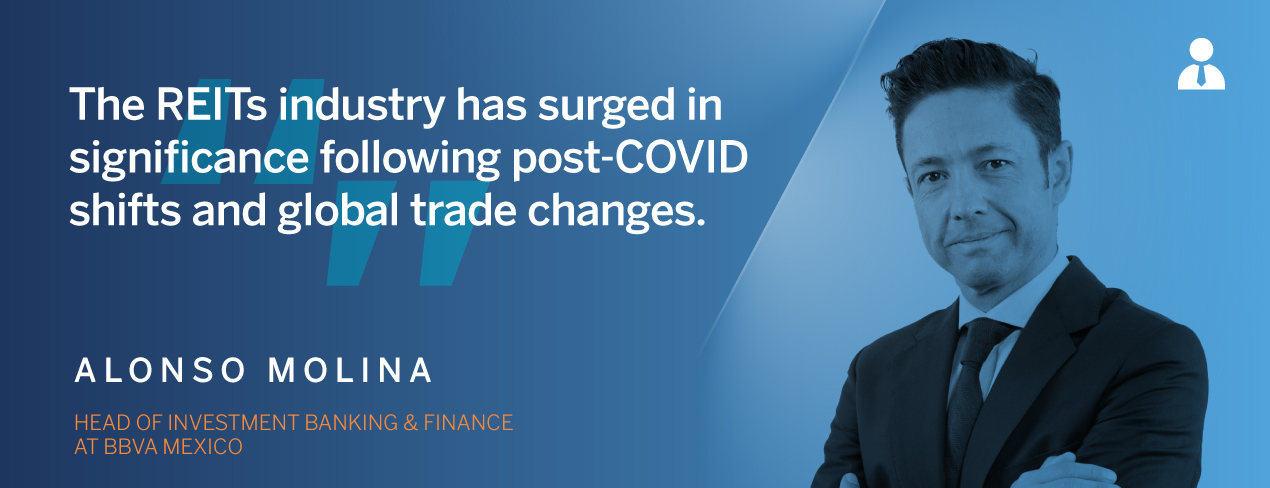
11 September 2023
REITs, current situation in Mexico
Alonso Molina, Head of Investment Banking & Finance BBVA México
A brief analysis of the Infrastructure and Real Estate Trusts (REITs) and their current situation in Mexico, provided by our expert Alonso Molina, Head of Investment Banking & Finance Mexico at BBVA CIB.
Over the past month, there have been over 141K public mentions related to REITs. In our latest LinkedIn Trending Data newsletter, we have cross-matched this data with with the over 26K mentions linked to #RealEstate&CapitalMarkets and over 54K on #Nearshoring&REITs and #RealEstateInvesting, to provide you with a brief analysis of the significance of Infrastructure and Real Estate Trusts, especially in Mexico.
Also, as usual, we've invited an industry expert to shed some light on this topic: Alonso Molina, Head of Investment Banking & Finance Mexico.
Real Estate and Infrastructure Trusts, which are widely recognized as REITs in the English-speaking world and as FIBRAs in Spanish-speaking regions, are relatively new in Mexico. Even though the first REITs were listed on the Mexican Stock Exchange in 2011, in the United States, they have been fostering large-scale real estate investments for over 60 years.
According to figures from AMEFIBRA, REITs' assets currently represent 4,5% of Mexico's gross domestic product (GDP) and are invested in a wide variety of properties such as industrial buildings, shopping centers, offices, hotels, hospitals, as well as agricultural, educational, and housing assets. Despite their significant penetration in the economy, these vehicles still have substantial potential for further growth; although they face some challenges.
The primary challenges faced by REITs:
- A demanding market | The growing emphasis on sustainability from stakeholders is clear. Investors and tenants are actively seeking to align with their respective ESG (Environmental, Social, Governance) strategies, such as projects that champion environmental care and inclusive economic growth. Furthermore, tenants demand facilities that enhance their efficiency ratios, not just financially but also in terms of emission reduction.
- Modernization and social initiatives | To address this, REITs are focusing on upgrading their properties with the goal of achieving certifications in sustainability standards like LEED, PCES, EDGE, among others. They're also undertaking initiatives aimed at enhancing the surroundings of the communities where they operate. As per AMEFIBRA, by the end of 2022, 6 million square meters of their affiliated properties were already certified under one of these standards, and 93% of them incorporated ESG criteria in their risk identification and assessment processes.
In the words of an expert

A favorable economic context that supports sectoral growth
The REITs sector has gained increased prominence in recent years, driven by post-Covid trends and shifts in global trade dynamics. One notable trend is Nearshoring or the relocation of supply chains, which has especially propelled the industrial segment.
To contextualize this, between 2019 and 2022, the demand for industrial space due to Nearshoring grew at an impressive compound annual rate of 73%. In 2022, nearly 26% of the total demand was attributed to this trend, compared to 15% in 2019, according to CBRE data. Given its proximity to the United States, Mexico's northern border states remain favored destinations for businesses looking to relocate to the country. However, central states are also gaining traction due to their fewer infrastructure constraints and significant logistical potential.
We anticipate REITs to sustain their growth trajectory, capitalizing on emerging market opportunities
It's not just the industrial segment that's been a driving force behind the REITs market's expansion. For instance, in the retail sector, we've observed a slow but steady recovery, attributed to an uptick in shopping mall footfall, allowing occupancy rates to remain stable and experience single-digit growth. In the office space segment, we believe the worst is behind us, and a gradual recovery is already taking shape.
Moving forward, we anticipate REITs to sustain their growth trajectory, capitalizing on emerging market opportunities. This is why at BBVA, we boast a broad and highly specialized portfolio, guiding our clients through these times in the best possible way and catering to all their needs across the entire value chain. We aim to mobilize over 200 billion pesos (around US $11.38 billion) across all sub-sectors, ranging from industrial to hospitality.
With our Real Estate sector experts at the helm, we aid our clients in identifying the best financing mechanism to actualize their growth plans. This might encompass support in structuring capital placements or debt issuance, crafting custom-made credit schemes for projects, or even assisting in finding counterparts for mergers, acquisitions, divestitures, among other processes.
Being aware that this growth needs to be more sustainable, we now have a specialized ESG Advisory wing. Through this, we support our clients in implementing strategies that transition towards greener and more inclusive actions within their firms. As an illustration, in 2021 and 2022, BBVA Mexico mobilized 25.944 billion pesos in operations tagged as green or sustainable in the Real Estate sector, which accounts for 17% of all Corporate Banking mobilization in Mexico during this period.




